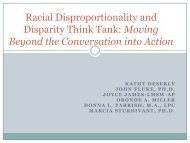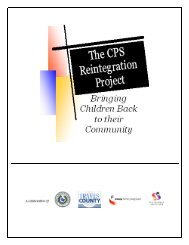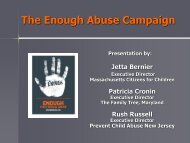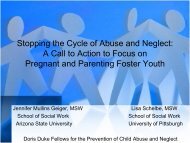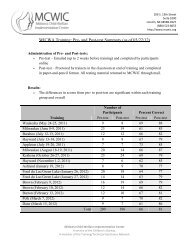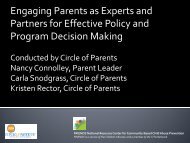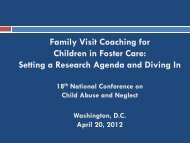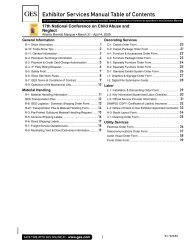Creating Trauma-Informed Child Welfare Systems ... - Pal-Tech
Creating Trauma-Informed Child Welfare Systems ... - Pal-Tech
Creating Trauma-Informed Child Welfare Systems ... - Pal-Tech
- No tags were found...
Create successful ePaper yourself
Turn your PDF publications into a flip-book with our unique Google optimized e-Paper software.
Definition of <strong>Trauma</strong>-<strong>Informed</strong> System –CTISP National Advisory CommitteeA trauma-informed child welfare system is one in whichall parties involved recognize and respond to thevarying impact of traumatic stress on children,caregivers and those who have contact with thesystem. Programs and organizations within the systeminfuse this knowledge, awareness and skills into theirorganizational cultures, policies, and practices. Theyact in collaboration, using the best available science, tofacilitate and support resiliency and recovery.
Definition of <strong>Trauma</strong>-<strong>Informed</strong> System –National <strong>Child</strong> <strong>Trauma</strong>tic Stress NetworkA trauma-informed child- and family-service system is one inwhich all parties involved recognize and respond to the impactof traumatic stress on those who have contact with the systemincluding children, caregivers, and service providers. Programsand agencies within such a system infuse and sustain traumaawareness, knowledge, and skills into their organizationalcultures, practices, and policies. They act in collaboration withall those who are involved with the child, using the bestavailable science, to facilitate and support the recovery andresiliency of the child and family.
Definition of <strong>Trauma</strong>-<strong>Informed</strong> System –National <strong>Child</strong> <strong>Trauma</strong>tic Stress Network, cont.A service system with a trauma-informed perspective is one in whichprograms, agencies, and service providers:(1) Routinely screen for trauma exposure and related symptoms;(2) Use culturally appropriate evidence-based assessment and treatment fortraumatic stress and associated mental health symptoms;(3) Make resources available to children, families, and providers on traumaexposure, its impact, and treatment;(4) Engage in efforts to strengthen the resilience and protective factors ofchildren and families impacted by and vulnerable to trauma;(5) Address parent and caregiver trauma and its impact on the family system;(6) Emphasize continuity of care and collaboration across child-servicesystems; and(7) Maintain an environment of care for staff that addresses, minimizes, andtreats secondary traumatic stress, and that increases staff resilience.
Call for <strong>Trauma</strong>-<strong>Informed</strong><strong>Child</strong>-Serving <strong>Systems</strong>What realistic and practicalactions can be taken at alllevels of the system tounderstand and address traumato make it better for thechildren, families, andworkforce?Artwork courtesy of the International <strong>Child</strong> Art Foundation (www.icaf.org)
NCTSN <strong>Child</strong> <strong>Welfare</strong> Committee• Helping <strong>Child</strong>ren in the <strong>Child</strong><strong>Welfare</strong> System Heal from <strong>Trauma</strong>:A <strong>Systems</strong> Integration Approach(2005)• <strong>Child</strong> <strong>Welfare</strong> <strong>Trauma</strong> TrainingToolkit (2008, currently beingrevised)• Caring for <strong>Child</strong>ren Who HaveExperienced <strong>Trauma</strong>: A Workshopfor Resource Parents (2010)• Sponsoring a Breakthrough Series Collaborative focusedon foster care placement stability (2010-2012)• Fact sheets on birth parent trauma (2011-2012)
Essential Elements of<strong>Trauma</strong>-<strong>Informed</strong> <strong>Child</strong> <strong>Welfare</strong> Practice(adapted from the <strong>Child</strong> <strong>Welfare</strong> <strong>Trauma</strong> Training Toolkit)1) Maximize the child’s sense of safety• Physical and psychological safety• Concept of triggers2) Utilize comprehensive assessment• Assess child’s traumatic experiences• Assess impact on the child’s development andbehavior• Let assessment guide services when appropriate3) Assist children in reducing overwhelming emotion
Essential Elements of<strong>Trauma</strong>-<strong>Informed</strong> <strong>Child</strong> <strong>Welfare</strong> Practice(adapted from the <strong>Child</strong> <strong>Welfare</strong> <strong>Trauma</strong> Training Toolkit)4) Address any impact of trauma and subsequentchanges in• <strong>Child</strong>’s behavior• Development• Relationships5) Help children make new meaning of their traumahistory and current experiences6) Coordinate services with other agencies7) How and when to apply the right evidence-basedtreatments
Essential Elements of<strong>Trauma</strong>-<strong>Informed</strong> <strong>Child</strong> <strong>Welfare</strong> Practice(adapted from the <strong>Child</strong> <strong>Welfare</strong> <strong>Trauma</strong> Training Toolkit)8) Support and promote positive and stablerelationships in the life of the child9) Provide support and guidance to child’s familyand caregivers10) Recognize that many of the child’s adultcaregivers are trauma victims as well (recent andchildhood trauma)11) Manage professional and personal stress• Vicarious <strong>Trauma</strong>
Why is this Important?The research is clear that the experience of abuse orneglect leaves a particular traumatic fingerprint on thedevelopment of children that cannot be ignored if the childwelfare system is to meaningfully improve the lifetrajectories of maltreated children, not merely keep themsafe from harm.Bryan Samuels, Commissioner for the Administration on <strong>Child</strong>, Youth and FamiliesTestimony to House Ways and Means Subcommittee on Human Resources, Congress
How do we get there from here?
“Every system is perfectlydesigned to achieve theresults it gets”ALLOW THE PEOPLE WITHIN THESYSTEM TO CHANGE THE SYSTEM
The Breakthrough Series Collaborative Approach• The BSC approach to quality improvement wasdeveloped in 1995 by the Institute for HealthcareImprovement and Associates in ProcessImprovement.• The BSC approach focuses on adapting,spreading, and adopting best practices acrossmultiple settings and on creating changes withinorganizations to promote the delivery of effectivepractices.
Rationale for Utilizing the BSC Approach“Bridge the gap between knowledge and practice”
Goal of the <strong>Trauma</strong>-<strong>Informed</strong> <strong>Child</strong><strong>Welfare</strong> BSC (TICWP-BSC)To develop and promote traumainformedpolicies and practicesrelated to foster care placement,thereby increasing placement stabilityand promoting a sense ofpermanency among children in care.
Using <strong>Trauma</strong>-<strong>Informed</strong> <strong>Child</strong> <strong>Welfare</strong> Practice toImprove Placement Stability:A Breakthrough Series Collaborative (TICWP-BSC)• Sponsored by the National Center for <strong>Child</strong> <strong>Trauma</strong>ticStress with funding from SAMHSA• Includes 9 sites from across the country (CO, FL, MA, NC,NH, OK, TX, Los Angeles and San Diego)• Public child welfare system is lead, but the team is apartnership between child welfare jurisdictions, partnermental health/trauma sites, and family representatives(youth, parents, foster parents)
Core Elements of a Breakthrough SeriesCollaborativeFaculty and PlanningTeamCollaborative ChangeFrameworkMulti-level, inclusiveparticipant teamsShared LearningEnvironmentExperiential, adultlearning strategiesModel for Improvement•Metrics•Dash Board•Improvements based on PDSAs•Mid-point consultations/postcollaborativeconsultations
Faculty and Planning Team –Typical CompositionFaculty• Mirror of theparticipant teams• All roles in theteams arerepresented on thefacultyPlanning Team• BSC Director• ImprovementAdvisor• Project Manager• AdministrativeSupport
TICWP-BSC Faculty and Planning Team• Co-Chairs – Charles Wilson and Erika Tullberg• Co-Directors – Susan Ko and Jan Markiewicz• Senior Leaders – Mary Gambon• <strong>Trauma</strong> Administrators and Clinicians – Cassandra Kisiel• <strong>Child</strong> <strong>Welfare</strong> Supervisors and Line Workers – Dori Brail• Consumers (foster parents, birth parents, and youth) –Amanda Pruitt• Program Manager – Lisa Conradi• Improvement Advisor – Heather Langan• Consultant – Jen Agosti
Collaborative Change FrameworkThe Collaborative Change Framework (CCF) willhave two primary sections: the CollaborativeCharter, which will set out the foundation forthe overall Breakthrough SeriesCollaborative, and the Key Objectives, whichwill serve as the roadmap for participatingteams as they test, implement, and strive tosustain their improvements.
Key Elements of the TICWP-BSCCollaborative Change FrameworkKnowledge Buildingand DevelopingPractice<strong>Trauma</strong>-<strong>Informed</strong>Mental HealthAssessmentCase Planning andManagementExternally Delivered<strong>Trauma</strong>-<strong>Informed</strong>Services<strong>Child</strong> <strong>Welfare</strong><strong>Systems</strong>, Cross-System Partnerships,and SystemCollaboration
Teams are comprisedof roles within theorganization and/orcommunity who areessential to thechange processMulti-level, Inclusive Team
Team Composition for TICWP-BSC• Nine teams participating (San Diego, Los Angeles,CO, TX, OK, FL, NC, NH, MA)• Team composition– Senior Leader – <strong>Child</strong> <strong>Welfare</strong> Administrator– Day-to-Day Manager– <strong>Child</strong> <strong>Welfare</strong> Supervisor– <strong>Child</strong> <strong>Welfare</strong> Line Worker– <strong>Trauma</strong> MH Administrator– Clinician– Foster Parent– Birth Parent– Youth (optional)– Cross-system partner (optional)
Shared Learning EnvironmentWe can learn more from collaborating than from working alone!
Model for ImprovementAn EFFECTIVE tool for Tackling Challenges!
BSC Model for Improvement:3 QuestionsWhat are we trying to accomplish?Team PriorityFramework ElementWhat changes can we make that will result in improvement?StrategiesHow will we know that a change is an improvement?MeasuresAdapted from 2001 Institute for Healthcare Improvement
Plan-Do-Study-Act (PDSA) Cycles:• A tool to tacklechallenges onseveral levels– Individual– Team– Organization(includingcommunityconnections)Small Tests of Change
Improvement Requires Change
Telling the Story of this Breakthrough SeriesMonthly MetricsDashboardsMidpointConsultationsPDSA DatabaseGraphsSurveysNarrativeOrganizationalAssessments
MONTHLYMETRICS• Monthly measures (must be sensitive to shortterm changes or shifts)• Indicators of progress toward objectives• NOT research data (contain some bias, nocontrols, not meant to be “laser images,” etc.)
Examples of Monthly Metrics Data fromthe TICWP-BSC1. Number of requests to move children out of aplacement (due to “negative” or behavioral issues)2. Number of actual moves each month3. Number of children in placement who received MHassessments4. Number of children in placement who receivedtrauma-focused screening or assessment5. Number of children receiving treatment (genericand trauma-focused EBP)
As of August, 2011:Data Highlights• 73% of children in placement had received a mentalhealth screening, compared to 31% at the beginningof the project.• 53% of children in placement had received a traumafocusedscreening, compared to 18% at thebeginning.• As number of children screened increased, numberof children identified as needing trauma treatmentincreased.
Data Highlights• Almost ¾ of foster parents surveyed saidthey were able to manage symptoms andbehaviors of children in their care.• Placement moves and move requestsdeclined (with minor ups and downs)throughout the project.• Several teams added data to what they arecollecting, and have plans to continue thiscollection after the BSC.
Initiating and Maintaining StrongPartnerships with State <strong>Child</strong> <strong>Welfare</strong>San Diego CountySuperChangersLive Well, San Diego!
San Diego Super Changers• October 2010 East Region, San Diego County, CWSbegins participation in <strong>Trauma</strong> BSC• Team Members: Casey Family Programs, ChadwickCenter, Vista Hill Foundation, Home Start, Parent,Foster Parent, Youth, TERM therapists, DependencyLegal Group, CWS Staff Psychologist, Schools, etc• Through our PDSA’s (small tests of change), we haveidentified practices that have been successful andwe are working on spreading throughout the countyLive Well, San Diego!
Live Well, San Diego!It’s “All About Me!”
<strong>Child</strong> <strong>Welfare</strong> <strong>Systems</strong>, Cross-System Partnerships, andSystem CollaborationPDSA: Help reduce trauma to children entering care by communicatingpertinent information about them to the out-of-home caregiver.PLAN: Protective Social Worker will have birth parent complete an “All About Me” formto be provided to the birth parent at the next removal.DO: The parents were asked to provide information about their child using the "All AboutMe" form.STUDY: The parents appeared to have decreased anxiety knowing that we valued theirthoughts on what their children needed.ACT: We will add the additional questions to the "All About Me" form. The survey willbe presented at lager group meetings for workers who are willing to begin usingimmediately.Live Well, San Diego!
Live Well, San Diego!<strong>Trauma</strong> Brochure
Knowledge Building and Developing PracticePDSA: Educate foster parents and birth parents about the effectsof traumaPLAN: The BSC Team created a brochure to give to caregivers and birth parents to helpeducate them about the effects of trauma on children.DO: This brochure is given to a couple of caregivers.STUDY: Caregivers provided feedback on the brochure and indicated that it was helpfulfor them to understand the effects of trauma on their children.ACT: Recommended changes were made to the brochure. Now it is given to allcaregivers.Live Well, San Diego!
Phone Call to Parents
<strong>Child</strong> <strong>Welfare</strong> <strong>Systems</strong>, Cross-SystemPartnerships, and System CollaborationPDSA: Developing stronger relationships between foster parentsand birth parentsPLAN: In East Region we are asking all caregivers to call birth parents within 24 hoursof child placement.DO: We have created a letter to caregivers that asks them to make the phone call,included the All About Me Form that can help them to get information, and includes abrochure on trauma.STUDY: The perception is that with placement staff educating all caregivers about theimportance of the relationship between caregivers and parents, the relationships arestarting to improve.ACT: Social workers are encouraging calls between foster parents and birth parentsacross cases.Live Well, San Diego!
TICWP Breakthrough Series Collaborative• More accomplishments‣ Birth Parent, Foster Parent and mental health partnerproviding trauma training for resource parents‣ BSC has made recommendations to mental health regardingensuring all TERM therapists are trauma trained andconducting standardized assessments using a trauma lens‣ Started training schools in East Region on how schools canbe more trauma informed‣ BSC work is helping to inform broader HHSA goal of ensuringthat all departments in HHSA are trauma informedLive Well, San Diego!
Integrated Training for Staff• Began training integrated SDM/Signs of Safety withEarly Adopters in November, 2010• Merged <strong>Child</strong>ren’s Research Center (SDM) and Signsof Safety experts to create and conduct the training• Currently training all staff on <strong>Trauma</strong>-<strong>Informed</strong>practice with links to SDM/SofS• SDM/SofS modules that begin in January 2012 thatwill include links to traumaLive Well, San Diego!
SDMSigns ofSafety<strong>Trauma</strong>-<strong>Informed</strong> LensSan DiegoCounty’sSafety-OrganizedPracticeLive Well, San Diego!
Values and Principles: Working with Families• Every family deserves our respect• Cooperate with the person, not the abuse• Cooperation is possible even where coercion isrequired• All families have acts of protection• Families deserve a process and assessmentsthat are reliable, valid and equitable• <strong>Trauma</strong>tic experiences affect families andshould inform how we work with them to tryto build safety.www.nccd-crc.orgLive Well, San Diego!
What Is <strong>Child</strong> <strong>Trauma</strong>tic Stress?• <strong>Child</strong> traumatic stress refers to the physicaland emotional responses of a child to eventsthat threaten the life or physical integrity ofthe child or of someone critically important tothe child (such as a parent or sibling).SDM Safety Threats• <strong>Trauma</strong>tic events overwhelm a child’scapacity to cope and elicit feelings of terror,powerlessness, and out-of-controlphysiological arousal.21Live Well, San Diego!21
• Solution-Focused Questions are tools you can useto surface past and current trauma.• The SDM Risk Assessment can surface past abuseand mental health concerns.• Safety Mapping consultation is a way to look at thisall together and include a trauma lens.Live Well, San Diego!
Live Well, San Diego!
Module 6:MANAGEPROFESSIONAL &PERSONAL STRESSPrevent and Mitigate Secondary <strong>Trauma</strong>tic StressEssential Element #9!2Live Well, San Diego!2
What Can Help Prevent or Mitigate Secondary<strong>Trauma</strong>tic Stress?Get into groups and each group will answer a question:•What can you do for yourself?•What can you do with your peers or as a team?•What can you do with your supervisor or what can your supervisor do?•What can the Agency do?134Live Well, San Diego!
Managing Stress: What<strong>Child</strong> <strong>Welfare</strong> Workers Can Do• Request and expect regular supervisionand supportive consultation.• Utilize peer support.• Consider therapy for unresolved trauma,which the child welfare work may beactivating (Employee Assistance Program)• Practice stress management throughmeditation, prayer, conscious relaxation,deep breathing, and exercise.• Develop a written plan focused onmaintaining work–life balance.Live Well, San Diego!
How Does this Look in Practice?• Voice of trauma in Safety Mapping Sessions• Consultation guidelines for managers and supervisors– SDM– Signs of Safety– <strong>Trauma</strong>• Changes to case consultation• Secondary <strong>Trauma</strong>tic Stress Champion in BSC Test Site• Implementing practices developed through BSC (All AboutMe Forms, Using <strong>Trauma</strong> Brochure to Educate, Phone CallBetween Resource Parent and Parent)Live Well, San Diego!
Next Steps• Train all staff in SDM/Signs of Safety with traumainformed practice principles infused into the modules• Ensure community partners are trained such asschools, parenting education providers, etc. in bothSigns of Safety and <strong>Trauma</strong> <strong>Informed</strong> Practice• Create and publish a <strong>Child</strong> <strong>Welfare</strong> Practice ModelFramework for San Diego CountyLive Well, San Diego!
Lessons Learned for Mental Health-<strong>Child</strong> <strong>Welfare</strong> Collaboration• Identify and map trauma-informed practices with child welfaresystem’s priorities (e.g., implementation of practice models, Signsof Safety, permanency efforts, etc.). <strong>Trauma</strong> will almost inevitablyimpact/intersect with them in some way.• Actively partner with families and youth throughout the process.They provide a critical perspective and have creative ideas toassist in informing and improving the system.• Empower and equip child welfare workers to conduct traumascreenings. This includes training on conducting screenings andmanaging secondary trauma that may emerge while conductingthe screenings, as well as guidance on how the screening resultscan inform their work with the child and family.
Lessons Learned for Mental Health-<strong>Child</strong> <strong>Welfare</strong> Collaboration• Think about and address trauma experienced by differentsystem stakeholders (children, parents, caseworkers,foster parents).• Think beyond linking children with mental healthtreatment – address other stakeholders/services withinchild welfare system (foster parents, mentors, parentingclasses, visitation, etc.)that can help identifyand mitigate traumaexperienced by children.
Lessons Learned for Mental Health-<strong>Child</strong> <strong>Welfare</strong> Collaboration• Share trauma-informed resourcesacross systems. This includestools, trainings, and other products.• Change should be made from boththe top-down AND bottom-upperspectives. If the hierarchy is flattened, there is moreroom for innovation, buy-in and, ultimately, systemchange.• Replace existing practices rather than add new practices– the child welfare workload is already overwhelming!
BSC Next Steps• Addressing Secondary <strong>Trauma</strong>tic Stress among staff andfoster parents» Faculty working with teams to address the developmentof two types of services:» Proactive efforts to mitigate the impact of secondarytraumatic stress (focus on psychoeducation, skill-buildingand self-care)» Responses to crisis situations» Focus on involving all members of staff hierarchy» Teams are exploring internal and external resources,how efforts can be integrated with ongoing supervisionand other existing activities• Developing agenda for 4 th Learning Session – national focus• Final report of BSC findings
Resources• Chadwick <strong>Trauma</strong>-<strong>Informed</strong> <strong>Systems</strong> Project –www.ctisp.org• California Evidence-Based Clearinghouse for <strong>Child</strong> <strong>Welfare</strong>- www.cebc4cw.org• National <strong>Child</strong> <strong>Trauma</strong>tic Stress Network - www.nctsn.organd http://learn.nctsn.org• Chadwick Center for <strong>Child</strong>ren and Families –www.ChadwickCenter.org• <strong>Child</strong> <strong>Welfare</strong> <strong>Trauma</strong> Training Toolkit -http://www.nctsn.org/nccts/nav.do?pid=ctr_cwtool• Caring for <strong>Child</strong>ren who Have Experienced <strong>Trauma</strong>: AGuide for Resource Parents - www.nctsn.org/rpc
Contact Information1) Erika TullbergACS-NYU <strong>Child</strong>ren's <strong>Trauma</strong> InstituteNYU Langone Medical CenterE-mail: Erika.Tullberg@nyumc.org2) Lisa Conradi, PsyDChadwick Center for <strong>Child</strong>ren andFamiliesE-mail: lconradi@rchsd.org3) Heather Langan, MA, LPCSNational Center for <strong>Child</strong> <strong>Trauma</strong>tic StressEvidence-Based Practice ImplementationCenterE-mail: heather.langan@dm.duke.edu4) Jessica Newmyer, MSWCounty of San Diego – <strong>Child</strong> <strong>Welfare</strong>ServicesE-mail: Jessica.Newmyer@sdcounty.ca.gov




